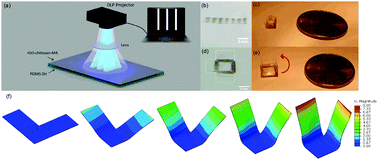当前位置:
X-MOL 学术
›
Soft Matter
›
论文详情
Our official English website, www.x-mol.net, welcomes your
feedback! (Note: you will need to create a separate account there.)
Patterned, morphing composites via maskless photo-click lithography.
Soft Matter ( IF 2.9 ) Pub Date : 2020-01-08 , DOI: 10.1039/c9sm02056j Shida Lyu 1 , Fei Zheng , Julio Adrian Aguilar-Tadeo , Fei Lin , Rui Wu , Brian Derby , Ian A Kinloch , Constantinos Soutis , Matthieu Gresil , Jonny J Blaker
Soft Matter ( IF 2.9 ) Pub Date : 2020-01-08 , DOI: 10.1039/c9sm02056j Shida Lyu 1 , Fei Zheng , Julio Adrian Aguilar-Tadeo , Fei Lin , Rui Wu , Brian Derby , Ian A Kinloch , Constantinos Soutis , Matthieu Gresil , Jonny J Blaker
Affiliation

|
Morphing materials, also known as smart materials are attracting increasing attention as sensors, actuators and in soft robotic applications. In this work bilayered morphing composites were created by exploiting the thiol-ene photoclick reaction via maskless digital light processing (DLP). This technique allows for gradients and patterns of near infrared (nIR)-triggered materials to be efficiently crosslinked to substrates, with suitable interfacial adhesion to realise complex morphing. Photo-thermally responsive composites are produced by DLP patterning of reduced graphene oxide-filled chitosan-methacrylamide (rGO-chitosan-MA) on thiolated polydimethylsiloxane substrates via thiol-ene photoclick reaction. Morphing composites with parallel striped patterns and box-like hinges were printed via DLP to realise self-rolling and self-folding behaviours. Bilayered structures, with gradient rGO-chitosan-MA thicknesses (2-8 μm), were produced by controlling the light intensity from the DLP device. These gradient bilayered structures enable photothermal-triggered gradient bending and morphing exemplified here by a "walking worm" and a kirigami-inspired "opening flower". Thermo-mechanical calculations were performed to estimate bending angles, and finite element analysis applied to simulate self-folding and bending. The difference between simulation and measurements is in the range 0.4-7.6%, giving confidence to the assumptions and simplifications applied in design.
中文翻译:

通过无掩膜照相点击光刻技术,对经过图案处理的变形复合材料进行处理。
变形材料,也称为智能材料,在传感器,执行器和软机器人应用中越来越受到关注。在这项工作中,通过无掩模数字光处理(DLP)利用硫醇-烯的光点击反应,创建了双层变形复合材料。该技术允许将近红外(nIR)触发的材料的梯度和图案有效地交联到基材,并具有合适的界面粘合力以实现复杂的变形。通过在硫醇化的聚二甲基硅氧烷基材上通过硫醇-烯光点击反应,对还原的氧化石墨烯填充的壳聚糖-甲基丙烯酰胺(rGO-壳聚糖-MA)进行DLP图案化,从而产生光热响应复合材料。通过DLP印刷具有平行条纹图案和盒状铰链的变形复合材料,以实现自滚动和自折叠行为。通过控制来自DLP装置的光强度,可以生产出具有rGO-壳聚糖-MA梯度厚度(2-8μm)的双层结构。这些梯度双层结构可以实现光热触发的梯度弯曲和变形,此处以“游走蠕虫”和由千里光启发的“开放花”为例。进行热机械计算以估计弯曲角度,并应用有限元分析来模拟自折叠和弯曲。仿真和测量之间的差异在0.4-7.6%的范围内,这使您对设计中采用的假设和简化充满信心。这些梯度双层结构可以实现光热触发的梯度弯曲和变形,此处以“游走蠕虫”和由千里光启发的“开放花”为例。进行热机械计算以估计弯曲角度,并应用有限元分析来模拟自折叠和弯曲。仿真和测量之间的差异在0.4-7.6%的范围内,这使您对设计中采用的假设和简化充满信心。这些梯度双层结构可以实现光热触发的梯度弯曲和变形,此处以“游走蠕虫”和由千里光启发的“开放花”为例。进行热机械计算以估计弯曲角度,并应用有限元分析来模拟自折叠和弯曲。仿真和测量之间的差异在0.4-7.6%的范围内,这使我们对设计中采用的假设和简化充满信心。
更新日期:2020-02-13
中文翻译:

通过无掩膜照相点击光刻技术,对经过图案处理的变形复合材料进行处理。
变形材料,也称为智能材料,在传感器,执行器和软机器人应用中越来越受到关注。在这项工作中,通过无掩模数字光处理(DLP)利用硫醇-烯的光点击反应,创建了双层变形复合材料。该技术允许将近红外(nIR)触发的材料的梯度和图案有效地交联到基材,并具有合适的界面粘合力以实现复杂的变形。通过在硫醇化的聚二甲基硅氧烷基材上通过硫醇-烯光点击反应,对还原的氧化石墨烯填充的壳聚糖-甲基丙烯酰胺(rGO-壳聚糖-MA)进行DLP图案化,从而产生光热响应复合材料。通过DLP印刷具有平行条纹图案和盒状铰链的变形复合材料,以实现自滚动和自折叠行为。通过控制来自DLP装置的光强度,可以生产出具有rGO-壳聚糖-MA梯度厚度(2-8μm)的双层结构。这些梯度双层结构可以实现光热触发的梯度弯曲和变形,此处以“游走蠕虫”和由千里光启发的“开放花”为例。进行热机械计算以估计弯曲角度,并应用有限元分析来模拟自折叠和弯曲。仿真和测量之间的差异在0.4-7.6%的范围内,这使您对设计中采用的假设和简化充满信心。这些梯度双层结构可以实现光热触发的梯度弯曲和变形,此处以“游走蠕虫”和由千里光启发的“开放花”为例。进行热机械计算以估计弯曲角度,并应用有限元分析来模拟自折叠和弯曲。仿真和测量之间的差异在0.4-7.6%的范围内,这使您对设计中采用的假设和简化充满信心。这些梯度双层结构可以实现光热触发的梯度弯曲和变形,此处以“游走蠕虫”和由千里光启发的“开放花”为例。进行热机械计算以估计弯曲角度,并应用有限元分析来模拟自折叠和弯曲。仿真和测量之间的差异在0.4-7.6%的范围内,这使我们对设计中采用的假设和简化充满信心。











































 京公网安备 11010802027423号
京公网安备 11010802027423号